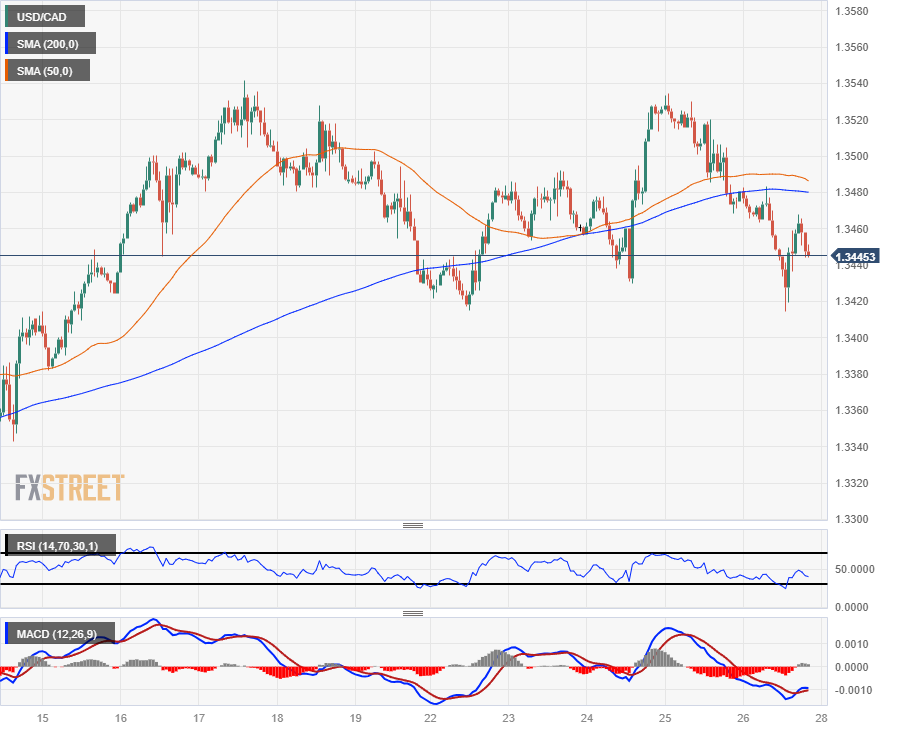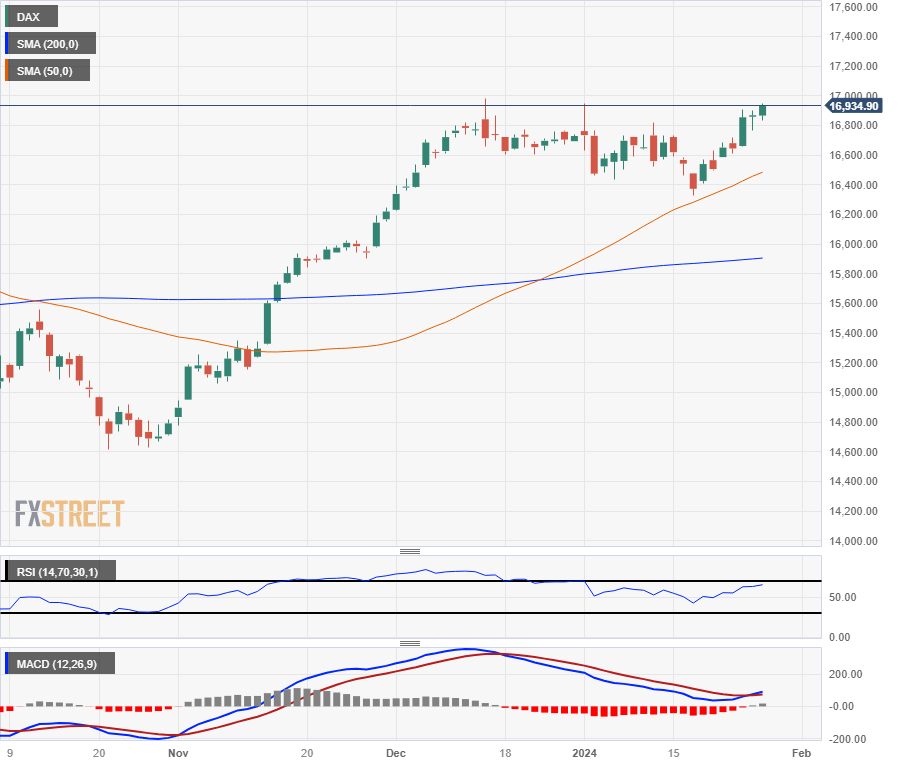Canadian Dollar caps off a mixed week with thin gains on Friday
- Canadian Dollar finds some room against the USD post-PCE print.
- Canada absent from the economic calendar until next Wednesday.
- Market focus to pivot toward upcoming Fed rate call.
The Canadian Dollar (CAD) found some space on Friday, bolstered by climbing Crude Oil markets and clawing back some of the week’s losses. The US Dollar Index (DXY) broadly fell early Friday ahead of US Personal Consumption Expenditure (PCE) figures, and the DXY saw a choppy recovery after the annualized Core PCE Price Index slid more than expected.
Canada is absent on the economic calendar until next Wednesday’s Canadian Gross Domestic Product (GDP) print, but effects are likely to be muted with broader markets focused on next week’s US Federal Reserve rate call and monetary policy statement.
Daily digest market movers: Canadian Dollar pares some of the week’s losses on Friday
- US Core PCE inflation printed at 2.9% YoY on Friday versus 3.0% forecast, 3.2% previously.
- Despite easing in Fed’s preferred inflation metric, US Personal Spending rose 0.7% MoM compared to the 0.4% forecast and 0.4% previous (revised up from 0.2%).
- US Pending Home Sales also rose 8.3% in December, well above the 1.5% forecast and the previous month’s -0.3% (revised down from 0.0%).
- US inflation continues to ease, but stubbornly robust consumption continues to weigh on rate cut hopes.
- Swap market bets of a Fed rate cut in March declined to 46% post-PCE release, falling back below 50%.
- According to the CME’s FedWatch Tool, markets are now pricing in May for the first rate cut.
- Next week’s Canadian MoM GDP for November expected to improve to 0.1% from 0.0%.
- Canada GDP to be engulfed by Fed rate call and Federal Open Market Committee (FOMC) press conference.
- Crude Oil markets saw new eight-week highs as supply concerns weigh on energy investors, West Texas Intermediate (WTI) US Crude Oil tests $77.00 per barrel on Friday.
Canadian Dollar price this week
The table below shows the percentage change of Canadian Dollar (CAD) against listed major currencies this week. Canadian Dollar was the strongest against the New Zealand Dollar.
| USD | EUR | GBP | CAD | AUD | JPY | NZD | CHF | |
| USD | 0.33% | -0.04% | 0.12% | 0.23% | -0.01% | 0.39% | -0.59% | |
| EUR | -0.34% | -0.37% | -0.21% | -0.23% | -0.34% | 0.06% | -0.88% | |
| GBP | 0.04% | 0.37% | 0.20% | 0.32% | 0.04% | 0.44% | -0.55% | |
| CAD | -0.12% | 0.21% | -0.16% | 0.12% | -0.12% | 0.30% | -0.65% | |
| AUD | -0.23% | 0.10% | -0.32% | -0.07% | -0.27% | 0.18% | -0.81% | |
| JPY | -0.01% | 0.32% | -0.04% | 0.14% | 0.20% | 0.42% | -0.59% | |
| NZD | -0.40% | -0.07% | -0.46% | -0.30% | -0.19% | -0.41% | -1.00% | |
| CHF | 0.59% | 0.90% | 0.54% | 0.69% | 0.78% | 0.57% | 0.97% |
The heat map shows percentage changes of major currencies against each other. The base currency is picked from the left column, while the quote currency is picked from the top row. For example, if you pick the Euro from the left column and move along the horizontal line to the Japanese Yen, the percentage change displayed in the box will represent EUR (base)/JPY (quote).
Technical Analysis: Canadian Dollar in the green for Friday but still soft on the week
The Canadian Dollar (CAD) found some room heading into the closing bell, gaining a third of a percent against the Japanese Yen (JPY) and around a quarter of a percent against the New Zealand Dollar (NZD). The CAD is flat on the day against the Euro (EUR) and shed a quarter of a percent against the rebounding Swiss Franc (CHF).
The Canadian Dollar pushed back against the US Dollar on Friday as USD/CAD fell to an intraday low of 1.3414, but a broad-market Greenback recovery pulled the pair back into the 1.3450 region.
The USD/CAD’s near-term decline from the week’s peak near 1.3530 saw the pair slide around 0.9% peak-to-trough, and the pair is now recovering toward the 200-hour Simple Moving Average (SMA) near 1.3480. On the top end, an intraday technical resistance zone is priced in around 1.3490.
A halting Friday decline leaves USD/CAD at risk of slumping back into a near-term congestion zone as the 50-day and 200-day SMAs consolidate into a technical swamp near the 1.3500 term.
USD/CAD Hourly Chart
USD/CAD Daily Chart 
Canadian Dollar FAQs
What key factors drive the Canadian Dollar?
The key factors driving the Canadian Dollar (CAD) are the level of interest rates set by the Bank of Canada (BoC), the price of Oil, Canada’s largest export, the health of its economy, inflation and the Trade Balance, which is the difference between the value of Canada’s exports versus its imports. Other factors include market sentiment – whether investors are taking on more risky assets (risk-on) or seeking safe-havens (risk-off) – with risk-on being CAD-positive. As its largest trading partner, the health of the US economy is also a key factor influencing the Canadian Dollar.
How do the decisions of the Bank of Canada impact the Canadian Dollar?
The Bank of Canada (BoC) has a significant influence on the Canadian Dollar by setting the level of interest rates that banks can lend to one another. This influences the level of interest rates for everyone. The main goal of the BoC is to maintain inflation at 1-3% by adjusting interest rates up or down. Relatively higher interest rates tend to be positive for the CAD. The Bank of Canada can also use quantitative easing and tightening to influence credit conditions, with the former CAD-negative and the latter CAD-positive.
How does the price of Oil impact the Canadian Dollar?
The price of Oil is a key factor impacting the value of the Canadian Dollar. Petroleum is Canada’s biggest export, so Oil price tends to have an immediate impact on the CAD value. Generally, if Oil price rises CAD also goes up, as aggregate demand for the currency increases. The opposite is the case if the price of Oil falls. Higher Oil prices also tend to result in a greater likelihood of a positive Trade Balance, which is also supportive of the CAD.
How does inflation data impact the value of the Canadian Dollar?
While inflation had always traditionally been thought of as a negative factor for a currency since it lowers the value of money, the opposite has actually been the case in modern times with the relaxation of cross-border capital controls. Higher inflation tends to lead central banks to put up interest rates which attracts more capital inflows from global investors seeking a lucrative place to keep their money. This increases demand for the local currency, which in Canada’s case is the Canadian Dollar.
How does economic data influence the value of the Canadian Dollar?
Macroeconomic data releases gauge the health of the economy and can have an impact on the Canadian Dollar. Indicators such as GDP, Manufacturing and Services PMIs, employment, and consumer sentiment surveys can all influence the direction of the CAD. A strong economy is good for the Canadian Dollar. Not only does it attract more foreign investment but it may encourage the Bank of Canada to put up interest rates, leading to a stronger currency. If economic data is weak, however, the CAD is likely to fall.